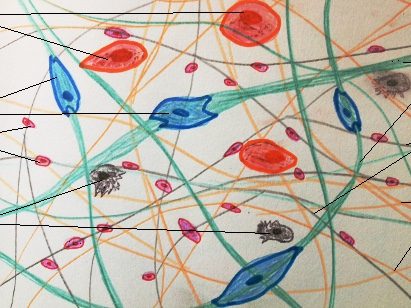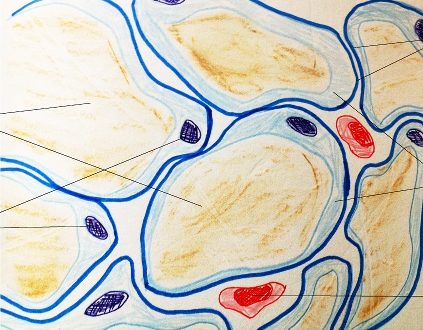Emotions in Cranio-sacral practice
Cranio-sacral work is known as a bodywork modality. The name itself points to physical structures, truly this practice is deeply rooted in the body. As practitioners, we learn anatomy, we learn how tissues move, we learn to listen through touch in very subtle ways. Supporting the physical body can be rich, grounding and healing.

Drawings of various tissues.. 
..done during my first CS training.. 
..back in 2016.
At the same time, the body is never just physical. Most people who come to this work arrive with more than one layer of difficulty — pain that doesn’t resolve, exhaustion that won’t lift, anxiety that keeps looping, symptoms that don’t respond to standard treatments. It is possible that underneath many of these patterns lie emotions that haven’t had their space. When we begin to settle the system, these emotions can start to move.
Many of us didn’t grow up learning how to feel our emotions in the body. We learned how to talk about them, suppress them, explain them, or judge them, but not how to feel them. Anger, sadness, fear, grief, joy, disgust… these are natural, embodied responses to life. When we don’t know how to be with them, they can fold into more complex states: stories about ourselves and others, tight patterns in the body, or symptoms that make no obvious sense. We not only have emotions as causal factors in symptoms, but we also have emotions about our symptoms – for example, fear that it won’t change.
Feeling happens in the body, and only in the body.
In cranio-sacral practice one of our goals is to come into connection with the feeling body. There is a lot going on, but this is a foundational aspect of the work. Emotions sometimes emerge as part of the body’s natural movement toward balance. My role is to offer presence, safety, and slowness so you can stay connected to yourself while something meaningful unfolds. This can happen in sessions or between sessions.
With the assistance of the practitioner the whole body-mind-heart system is moving toward optimal health, and if emotions are involved in a difficulty, this intelligent system will start bringing them to the surface. One key to supporting this is staying present in the body and slowing things down, another is relationships that foster compassion and self-understanding.
Feeling happens in the body, and only in the body.
This isn’t necessarily about big expression, though it can be. Often it’s about returning to simple sensations. Heat in the chest. Soft trembling in the belly. A sense of pressure behind the eyes. When we can meet it gently, the whole system has more space to reorganise. This can be very subtle: a softening in the diaphragm, a wave through the spine, the sense of something long-held beginning to uncoil. Other times there may be tears, frustration, or old fear.
Sometimes we think: “If I feel this feeling, it will never stop.”
In my experience, the opposite is true. When an emotion has the right conditions — support, pacing, and embodied awareness — it moves in its own time and finds its own end. Even when we can’t predict a clear ‘resolution’, any emotion can become more bearable when felt in small, manageable waves, without any pressure or hurry.
Learning to be intimate with our emotions is a skill. At first it may feel unfamiliar or messy. Over time it becomes clearer, more nuanced, and less frightening. We begin to understand what the body is trying to do, what it is asking for, what action or care is needed next. Besides professional support, writing by hand about what we feel can be a great way to access our emotions, as can connecting with others who can feel with us and help us see ourselves.
Cranio-sacral practice can connect us to the feeling, knowing body, the part of us that knows how to heal when the mind is tired of trying to work it all out. When the body is met with presence and kindness, it often begins to soften, recalibrate, and come back into itself. And in that returning, emotions can find their rightful place, as guides, signals, and expressions of our deeper life.
